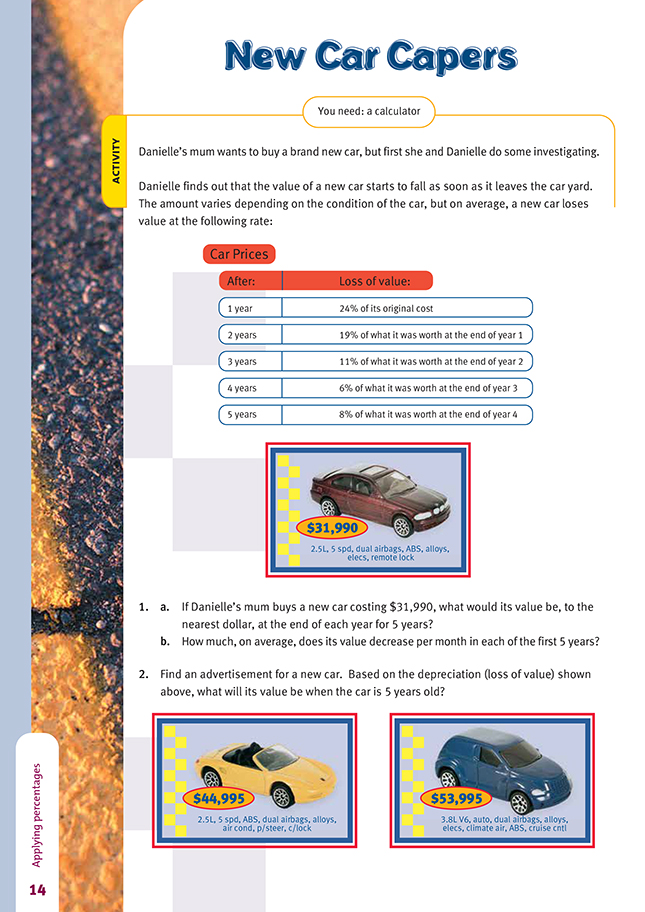This is a level 4 number link activity from the Figure It Out series. It relates to Stage 7 of the Number Framework.
A PDF of the student activity is included.
Click on the image to enlarge it. Click again to close. Download PDF (186 KB)
find percentages of a whole number
FIO, Link, Number, Book Three, New Car Capers, page 14
A calculator
In this activity, the students need to use their knowledge of percentages to work out the depreciation of a car over a period of time. They need similar skills to those used for the activity on page 5 of the student book.
Using a calculator for this activity would allow the students to focus on the meaning and reasonableness of their answers and not get bogged down with computations. However, the students do need to be able to check that the answer on the calculator is likely to be correct. Quickly estimating the answer before using the calculator is a good way to do this. For example, 50% is the same as a half, which is the same as dividing by 2. So 50% of $12,000 is $6,000. 25% is half of 50%, so half and then half again gives you 25%. So for 25% of $12,000, half and then half again equals $3,000.
If you know that 10% of 12 000 is 1 200, then you can work out:
• 5% by halving the 1 200, so 5% of 12 000 is 600;
• 20% by doubling it, so 20% is 1 200 + 1 200 = 2 400;
• 30% by adding the amount three times, so 30% is 1 200 + 1 200 + 1 200 = 3 600;
• 90% by taking 10% from the whole amount, so 90% is 12 000 – 1 200 = 10 800; and so on.
The usual approach taken to working out depreciation is to first work out the percentage depreciated and then to subtract that from the total. This approach is recommended as the students come to understand the concept. This is a good activity to use to introduce the memory button on a calculator if the students are not
familiar with its use. Once the students have a good understanding, challenge them to think of more efficient methods. Asking a question such as “Is finding 75% of a quantity the same as finding 25% and subtracting it from the quantity?” could be used to get them thinking.
Questions to promote more thinking could include:
“Why do you think the depreciation rate starts to go up after 5 years?”
“Is it likely to keep going up?”
“Could the depreciation rate ever be 110%?”
“After how many years will the car be worth nothing?”
Challenge the students to design a spreadsheet that will automatically work out the depreciation once they have entered the car’s original cost.
The value of the car in question 1a could be worked out like this:
Value after 1 year = $31,990 x 0.76 = $24,312
Value after 2 years = $24,312 x 0.81 = $19,693 and so on.
For question 1b, the yearly decrease needs to be divided by 12 to get the monthly average. For example, $31,990 x 0.24 = $7,678 (the decrease for the year). $7,678 ÷ 12 = $640, the average monthly decrease over that period of time. For the fifth year, the decrease is ($16,475 – $15,157) ÷ 12, which is $110.
Answers to Activity
1. a. End of 1st year: $24,312
End of 2nd year: $19,693
End of 3rd year: $17,527
End of 4th year: $16,475
End of 5th year: $15,157
b. 1st year: $640 (rounded) per month
2nd year: $385 per month
3rd year: $181 per month
4th year: $88 per month
5th year: $110 per month
2. Answers will vary. Teacher to check
